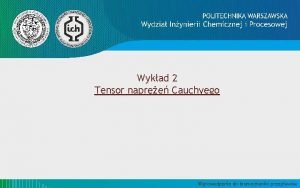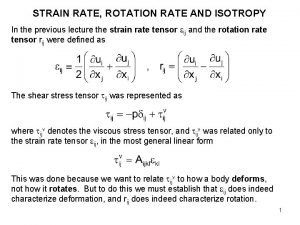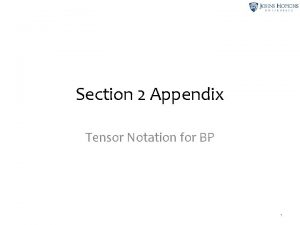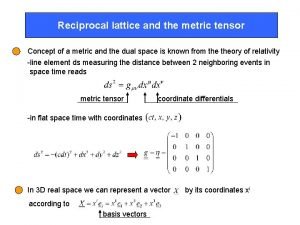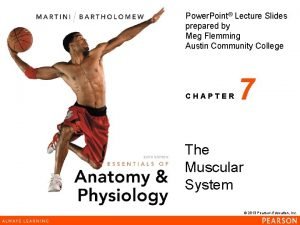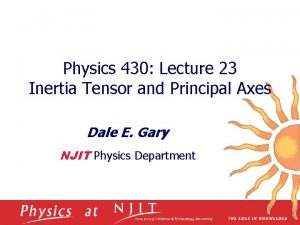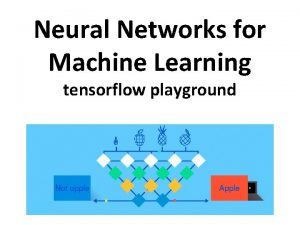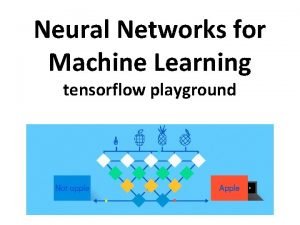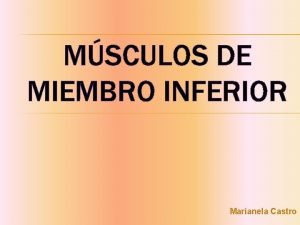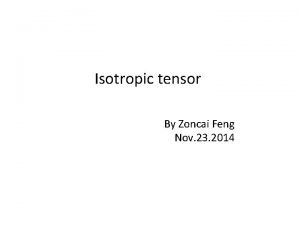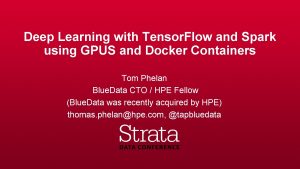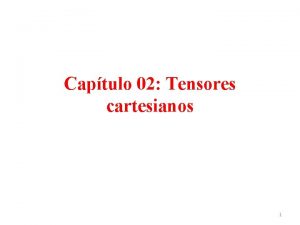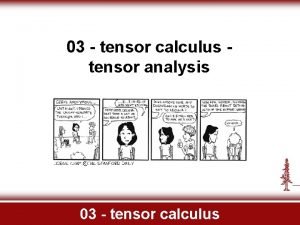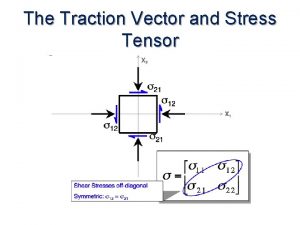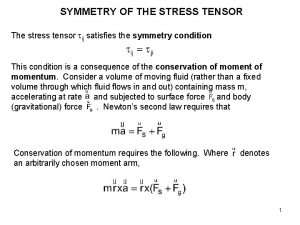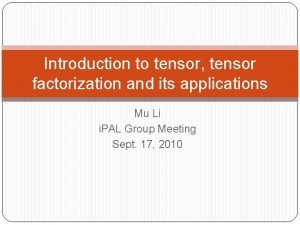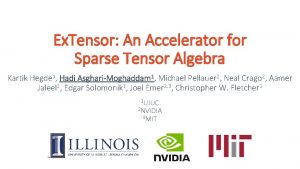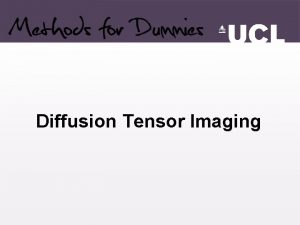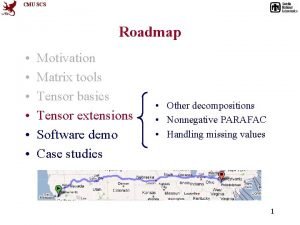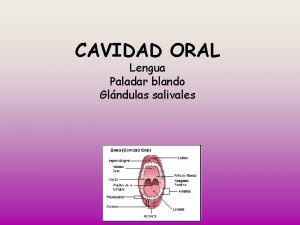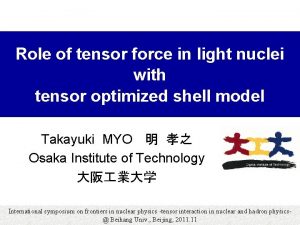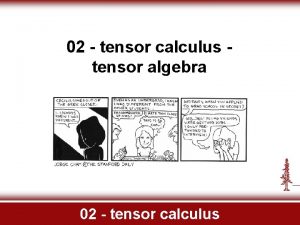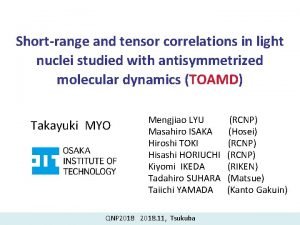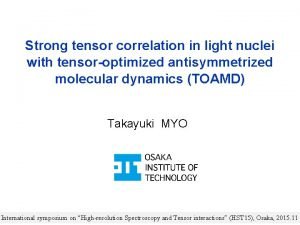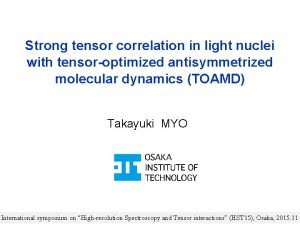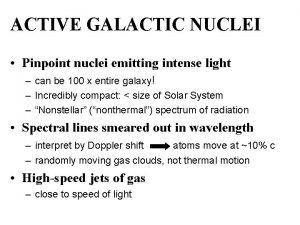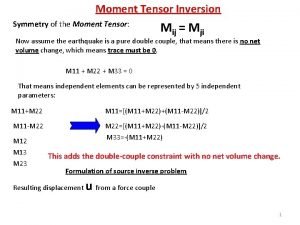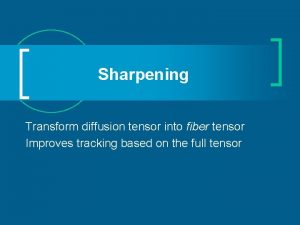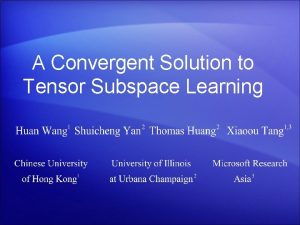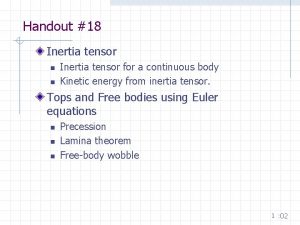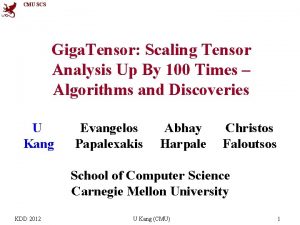Role of tensor force in light nuclei with





























- Slides: 29

Role of tensor force in light nuclei with tensor optimized shell model Takayuki MYO 明 孝之 Osaka Institute of Technology 大阪 業大学 1 International symposium on frontiers in nuclear physics -tensor interaction in nuclear and hadron physics@ Beihang Univ. , Beijing, 2011. 11

Purpose & Outline • Role of Vtensor in the nuclear structure by describing strong tensor correlation explicitly. • Tensor Optimized Shell Model (TOSM) to describe tensor correlation. • Unitary Correlation Operator Method (UCOM) to describe short-range correlation. • TOSM+UCOM to He & Li isotopes with Vbare • Halo formation in 11 Li − Coexistence of tensor and pairing correlations 2

Deuteron properties & tensor force S AV 8’ Energy -2. 24 Me. V Kinetic 19. 88 Central -4. 46 D Tensor -16. 64 LS Vcentral AV 8’ r Rm(s)=2. 00 fm Rm(d)=1. 22 fm Vtensor -1. 02 P(L=2) 5. 77% Radius 1. 96 fm d-wave is “spatially compact” (high momentum)

Tensor-optimized shell model (TOSM) TM, Sugimoto, Kato, Toki, Ikeda • Configuration mixing within 2 p 2 h excitations with high-L orbits. PTP 117(2007)257 4 He TM et al. , PTP 113(2005) TM et al. , PTP 117(2007) • Length parameters such as b 0 s, b 0 p , … are optimized independently, or superposed by many Gaussian bases. – Spatial shrinkage of D-wave as seen in deuteron HF by Sugimoto et al, (NPA 740) / Akaishi (NPA 738) RMF by Ogawa et al. (PRC 73), AMD by Dote et al. (PTP 115) • Satisfy few-body results with Minnesota central force (4, 6 He) 4

Hamiltonian and variational equations in TOSM (0 p 0 h+1 p 1 h+2 p 2 h) Particle state : Gaussian expansion for each orbit Gaussian basis function TOSM code : p-shell region c. m. excitation is excluded by Lawson’s method

Configurations in TOSM Gaussian expansion particle states C 0 C 1 C 2 nlj proton neutron hole states (harmonic oscillator basis) Application to Hypernuclei by Umeya (NIT) to investigate N- N coupling C 3

Unitary Correlation Operator Method TOSM (short-range part) short-range correlator Bare Hamiltonian Shift operator depending on the relative distance Amount of shift, variationally determined. 2 -body cluster expansion H. Feldmeier, T. Neff, R. Roth, J. Schnack, NPA 632(1998)61 7

4 He in TOSM + S-wave UCOM T (exact) Kamada et al. PRC 64 (Jacobi) TM, H. Toki, K. Ikeda PTP 121(2009)511 • variational calculation VLS E • Gaussian expansion VC with 9 Gaussians VT good convergence 8

4 -8 He with TOSM+UCOM • Difference from 4 He in Me. V TM, A. Umeya, H. Toki, K. Ikeda PRC 84 (2011) 034315 ~6 Me. V in 8 He using GFMC • No VNNN • No continuum ~7 Me. V in 8 He using Cluster model (PLB 691(2010)150 , TM et al. ) 4 p 4 h in TOSM

4 -8 He with TOSM+UCOM • Excitation energies in Me. V TM, A. Umeya, H. Toki, K. Ikeda PRC 84 (2011) 034315 • Bound state app. • No continuum • Excitation energy spectra are reproduced well • No VNNN

5 -9 Li with TOSM+UCOM • Excitation energies in Me. V Preliminary results • Bound state app. • No continuum • Excitation energy spectra are reproduced well • No VNNN

4 -8 He with TOSM • Excitation energies in Me. V Minnesota force (Central+LS)

5 -9 Li with TOSM • Excitation energies in Me. V Minnesota force (Central+LS)

Matter radius of He isotopes in TOSM(AV 8’) Cluster model TM, R. Ando, K. Kato PLB 691(2010)150 AHe=a+4 n Expt TOSM with AV 8’ Halo Skin 14 I. Tanihata et al. , PLB 289(‘ 92)261 G. D. Alkhazov et al. , PRL 78(‘ 97)2313 O. A. Kiselev et al. , EPJA 25, Suppl. 1(‘ 05)215. P. Mueller et al. , PRL 99(2007)252501

Configurations of 4 He in TOSM (0 s 1/2)4 83. 0 % (0 s 1/2)− 2 JT(p 1/2)2 JT JT=10 2. 6 JT=01 0. 1 (0 s 1/2)− 210(1 s 1/2)(d 3/2)10 2. 3 (0 s 1/2)− 210(p 3/2)(f 5/2)10 1. 9 Radius [fm] 1. 54 • 4 He TM, H. Toki, K. Ikeda PTP 121(2009)511 • deuteron correlation with (J, T)=(1, 0) Cf. R. Schiavilla et al. (VMC) PRL 98(2007)132501 R. Subedi et al. (JLab) Science 320(2008)1476 contains p 1/2 of “pn-pair” – Same feature in 5 He-8 He ground state 12 C(e, e’p. N) S. C. Simpson, J. A. Tostevin PRC 83(2011)014605 12 C 10 B+pn 15

4 -8 He with TOSM+UCOM • Excitation energies in Me. V • No VNNN • No continuum • Excitation energy spectra are reproduced well

Tensor correlation in 6 He val. -n Ground state halo state (0+) Excited state Tensor correlation is suppressed due to Pauli-Blocking TM, K. Kato, K. Ikeda, J. Phys. G 31 (2005) S 1681 17

6 He : Hamiltonian component in TOSM • Difference from 4 He in Me. V 6 He n 2 config DKin. 0+ 1 0+ 2 (p 3/2)2 (p 1/2)2 53. 0 34. 3 same trend in 5 -8 He LS splitting energy in 5 He DCentral 27. 8 14. 1 DTensor 12. 0 0. 2 DLS bhole=1. 5 fm 4. 0 2. 1 =18. 4 Me. V (hole) • Terasawa, Arima PTP 23 (’ 60) • Nagata, Sasakawa, Sawada, Tamagaki, PTP 22(’ 59) • Myo, Kato, Ikeda, PTP 113 (’ 05)

Characteristics of Li-isotopes Halo structure ü Breaking of magicity N=8 • 10 -11 Li, 11 -12 Be • 11 Li … (1 s)2 ~ 50%. (Expt by Simon et al. , PRL 83) • Mechanism is unclear Tanihata et al. , PRL 55(1985)2676. PLB 206(1998)592. 11 Li 19

High-momentum Pairing-blocking : 20 K. Kato, T. Yamada, K. Ikeda, PTP 101(‘ 99)119, Masui, S. Aoyama, TM, K. Kato, K. Ikeda, NPA 673('00)207. TM, S. Aoyama, K. Kato, K. Ikeda, PTP 108('02)133, H. Sagawa, B. A. Brown, H. Esbensen, PLB 309('93)1.

11 Li with 9 Li. TOSM+n+n cluster model • System is solved based on RGM 9 Li TOSM basis 11 Li • Orthogonality Condition Model (OCM) is applied. 21 TM, K. Kato, H. Toki, K. Ikeda PRC 76(2007)024305

Energy surface for b-parameter in 9 Li TOSM Vtensor is optimized with shrunk HO basis nn pn pairing correlation Dominant part of the tensor correlation cf. 1 st order (residual interaction): T. Otsuka et al. PRL 95(2005)232502.

11 Li properties (S 2 n=0. 31 Me. V) Simon et al. Rm P(s 2) Tensor (pn) +Pairing (nn) DE = 0. 1 Me. V Pairing correlation between halo neutrons couples (0 p)2 and (1 s)2 23 TM, K. Kato, H. Toki, K. Ikeda, PRC 76(2007)024305 TM, Y. Kikuchi, K. Kato, H. Toki, K. Ikeda, PTP 119(2008)561

Coulomb breakup strength of 11 Li No three-body resonance E 1 strength by using the Green’s function method +Complex scaling method +Equivalent photon method (TM et al. , PRC 63(’ 01)) T. Myo, K. Kato, H. Toki, K. Ikeda PRC 76(2007)024305 • Expt: T. Nakamura et al. , PRL 96, 252502(2006) • Energy resolution with =0. 17 Me. V. 24

Virtual s-wave states in 10 Li • 1 s 1/2 virtual state: as : scattering length of 9 Li+n 12 - Inert core +1. 4 fm +0. 8 fm Tensor +Pairing – 5. 6 fm – 17. 4 fm T. M. et al. , PTP 119(’ 08)561 ar. Xiv: 0803. 0590 Expt. M. Thoennessen et al. , PRC 59 (1999)111. M. Chartier et al. PLB 510(2001)24. H. B. Jeppesen et al. PLB 642(2006)449. as = – 10 ~ – 25 fm Pauli-blocking naturally describes virtual s-state in 10 Li 25

Summary • TOSM+UCOM with bare nuclear force. • 4 He contains much “pn-pair of p 1/2”. • He isotopes with p 3/2 has large contributions of Vtensor & Kinetic energy. • Halo formation in 11 Li with tensor and pairing correlations. Review Di-neutron clustering and deuteron-like tensor correlation in nuclear structure focusing on 11 Li K. Ikeda, T. Myo, K. Kato and H. Toki Springer, Lecture Notes in Physics 818 (2010) “Clusters in Nuclei” Vol. 1, 165 -221. 26

Charge Radii of Li isotopes 9 Li G RC-2 n Charge Radius 11 Li 9 Li Inert core Tensor Expt. +Pairing (Sanchez et al. , PRL 96(‘ 06)) RC-2 n 4. 67 5. 69 [fm] P(s 2) 4 47 % 27

2 n correlation density in 11 Li s 2=4% 9 Li Cigar type config. 9 Li s 2=47% n n Di-neutron type config. H. Esbensen and G. F. Bertsch, NPA 542(1992)310 K. Hagino and H. Sagawa, PRC 72(2005)044321 28

11 Li G. S. properties (S 2 n=0. 31 Me. V) Rm Simon et al. P(s 2) E(s 2)-E(p 2) 2. 1 (nn) (pn) 1. 4 0. 5 Tensor +Pairing -0. 1 [Me. V] Pairing correlation couples (0 p)2 and (1 s)2 for last 2 n 29
 Light light light chapter 23
Light light light chapter 23 Into the light chapter 22
Into the light chapter 22 Chapter 22
Chapter 22 Azure web role vs worker role
Azure web role vs worker role Krappmann role taking
Krappmann role taking Role conflict occurs when fulfilling the role expectations
Role conflict occurs when fulfilling the role expectations Tensor naprężeń
Tensor naprężeń Rotation rate tensor
Rotation rate tensor Tensor notation
Tensor notation Scalar vector tensor
Scalar vector tensor Reciprocal lattice concept
Reciprocal lattice concept Tensor vaginae femoris
Tensor vaginae femoris Inertia tensor of cone
Inertia tensor of cone Tensor flow playground
Tensor flow playground Tensor flow playground
Tensor flow playground Musculo aductor mayor
Musculo aductor mayor Isotropic tensor
Isotropic tensor Tensor tympani muscle
Tensor tympani muscle Wholesale spark mllib
Wholesale spark mllib Tensor de reynolds
Tensor de reynolds Produto externo de vetores
Produto externo de vetores Tensor integral
Tensor integral Stress sign convention
Stress sign convention Symmetry of stress tensor
Symmetry of stress tensor Tensor factorization
Tensor factorization Extensor: an accelerator for sparse tensor algebra
Extensor: an accelerator for sparse tensor algebra Tensor
Tensor Tensor basics
Tensor basics Musculo amigdalogloso
Musculo amigdalogloso Atl language tensor
Atl language tensor






